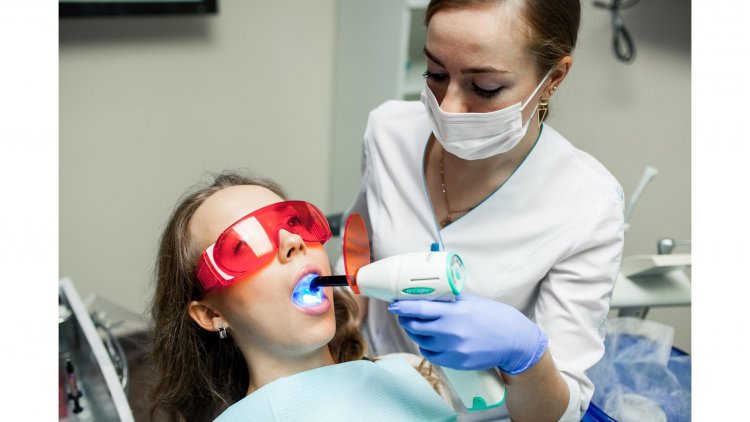The Shining Secrets of Modern Dentistry: Unveiling Advanced Dental Treatments
Dental health is more than just a sparkling smile; it's a critical component of overall well-being. Modern dentistry offers an array of advanced treatments that go beyond traditional cleanings and fillings. These innovative procedures not only enhance aesthetic appeal but also address complex dental issues, ensuring optimal oral health. This article delves into the cutting-edge treatments available today, exploring their benefits, processes, and the transformative impact they can have on patients' lives.

The Evolution of Dental Treatments
Dentistry has evolved remarkably over the past few decades. From primitive tools and techniques to sophisticated, high-tech procedures, the field has undergone a significant transformation. This evolution has been driven by advancements in technology, materials, and a deeper understanding of oral health's role in overall wellness. Today's dental treatments are designed to be more efficient, less invasive, and highly effective.
Cosmetic Dentistry: Beyond the Aesthetics
Cosmetic dentistry focuses on improving the appearance of teeth, gums, and smiles. However, it often has functional benefits as well. Here are some of the most popular cosmetic treatments:
Teeth Whitening
Teeth whitening is one of the most sought-after cosmetic dental treatments. Professional whitening procedures offer more dramatic and longer-lasting results compared to over-the-counter products. Dentists use high-concentration bleaching agents that penetrate deep into the enamel, removing stains caused by coffee, tea, smoking, and aging.
Veneers
Veneers are thin, custom-made shells designed to cover the front surface of teeth. Made from porcelain or composite resin, they are used to correct a variety of dental imperfections, including discolored, chipped, or misaligned teeth. Veneers provide a natural look and are highly resistant to stains.
Dental Bonding
Dental bonding involves applying a tooth-colored resin to repair decayed, chipped, or cracked teeth. The resin is shaped and polished to match the surrounding teeth, providing a seamless repair. This procedure is quick, typically completed in one visit, and is a cost-effective alternative to crowns and veneers.
Restorative Dentistry: Rebuilding Oral Health
Restorative dentistry focuses on repairing and restoring damaged teeth and gums. It is essential for maintaining proper function and preventing further oral health issues.
Dental Implants
Dental implants are the gold standard for replacing missing teeth. An implant consists of a titanium post surgically inserted into the jawbone, acting as a root for a replacement tooth. Once the post integrates with the bone, a crown is attached, providing a natural-looking and functional tooth. Implants help preserve the jawbone and prevent the shifting of adjacent teeth.
Crowns and Bridges
Crowns are caps placed over damaged or decayed teeth, restoring their shape, size, and strength. They can be made from various materials, including porcelain, ceramic, and metal. Bridges are used to replace one or more missing teeth, anchored by crowns on either side of the gap. These solutions improve chewing and speaking abilities and enhance the smile's appearance.
Dentures
Dentures are removable appliances that replace missing teeth and surrounding tissues. There are two main types: complete dentures, for those who have lost all their teeth, and partial dentures, for patients who have some natural teeth remaining. Modern dentures are more comfortable and natural-looking than their predecessors.
Orthodontics: Aligning Smiles with Precision
Orthodontics involves diagnosing, preventing, and treating dental and facial irregularities. While braces are often associated with children and teenagers, many adults are also seeking orthodontic treatment to achieve a healthier, more attractive smile.
Traditional Braces
Traditional metal braces consist of brackets bonded to the teeth and connected by wires. They gradually move teeth into the desired position over time. Today's braces are smaller, lighter, and more comfortable than those of the past. They are highly effective for correcting complex dental issues.
Clear Aligners
Clear aligners, such as Invisalign, have revolutionized orthodontic treatment. These custom-made, transparent trays fit snugly over the teeth and are virtually invisible. Aligners are removable, allowing for easy cleaning and the ability to eat without restrictions. They are a popular choice for adults and teenagers seeking a discreet orthodontic solution.
Periodontics: Caring for the Foundation of Oral Health
Periodontics focuses on the prevention, diagnosis, and treatment of periodontal disease, which affects the gums and supporting structures of the teeth. Periodontal health is crucial for overall oral wellness and can impact systemic health.
Scaling and Root Planing
Scaling and root planing is a deep cleaning procedure used to treat gum disease. Scaling removes plaque and tartar from above and below the gum line, while root planing smooths the tooth roots to help gums reattach to the teeth. This treatment can prevent the progression of gum disease and improve oral health.
Gum Grafting
Gum grafting is a surgical procedure used to treat receding gums. It involves taking tissue from another part of the mouth or using donor tissue to cover exposed tooth roots. This helps reduce sensitivity, protect the roots from decay, and improve the appearance of the gums.
Laser Therapy
Laser therapy is an advanced treatment for gum disease and other periodontal issues. Lasers can remove infected tissue, reduce bacteria, and promote healing with minimal discomfort. This less invasive option often results in quicker recovery times compared to traditional surgical methods.
Endodontics: Saving Natural Teeth
Endodontics is the branch of dentistry that deals with the diagnosis and treatment of dental pulp and root canal-related issues. Preserving natural teeth is the primary goal of endodontic treatment.
Root Canal Therapy
Root canal therapy is performed to save a tooth that is severely infected or decayed. The procedure involves removing the infected pulp, cleaning and disinfecting the inside of the tooth, and filling it with a biocompatible material. A crown is typically placed over the tooth to restore its function and appearance. Root canals have a high success rate and can save teeth that would otherwise need to be extracted.
Apicoectomy
An apicoectomy is a surgical procedure used when root canal therapy is not sufficient to treat an infection. It involves removing the tip of the tooth's root and sealing the root canal. This treatment can eliminate persistent infection and save the tooth.
Sedation Dentistry: Comfort and Anxiety Relief
Sedation dentistry uses medication to help patients relax during dental procedures. It is particularly beneficial for those with dental anxiety, a low pain threshold, or complex treatment needs.
Types of Sedation
-
Nitrous Oxide (Laughing Gas): This mild sedative is inhaled through a mask placed over the nose. It induces a state of relaxation and reduces pain sensitivity. The effects wear off quickly, allowing patients to resume normal activities soon after the procedure.
-
Oral Sedation: Oral sedatives, typically in pill form, are taken before the appointment. They produce a moderate level of sedation, helping patients feel drowsy and relaxed. Oral sedation is suitable for longer or more invasive procedures.
-
IV Sedation: Intravenous (IV) sedation delivers sedatives directly into the bloodstream. This method provides a deeper level of sedation and is closely monitored by the dentist or an anesthesiologist. It is ideal for patients undergoing extensive treatments.
-
General Anesthesia: General anesthesia renders the patient completely unconscious. It is used for complex dental surgeries and is administered by an anesthesiologist in a hospital or specialized clinic.
Pediatric Dentistry: Nurturing Young Smiles
Pediatric dentistry focuses on the oral health of children from infancy through adolescence. Pediatric dentists are specially trained to handle the unique needs of young patients, ensuring a positive dental experience.
Early Dental Care
Early dental visits, typically starting by the age of one, are crucial for monitoring the development of a child's teeth and gums. These visits help establish good oral hygiene habits and allow for the early detection of potential issues.
Preventive Treatments
-
Fluoride Treatments: Fluoride is a mineral that strengthens tooth enamel and prevents cavities. Fluoride treatments involve applying a concentrated fluoride solution to the teeth, providing extra protection against decay.
-
Dental Sealants: Sealants are thin, protective coatings applied to the chewing surfaces of the back teeth. They act as a barrier against food particles and bacteria, reducing the risk of cavities.
Orthodontic Evaluations
Early orthodontic evaluations can identify bite and alignment issues that may require intervention. Pediatric dentists work closely with orthodontists to develop treatment plans that ensure proper jaw and tooth development.

Holistic Dentistry: Integrative Oral Health
Holistic dentistry, also known as biological dentistry, takes a comprehensive approach to dental care, considering the patient's overall health and well-being.
Natural and Non-Toxic Materials
Holistic dentists prioritize the use of biocompatible and non-toxic materials in dental treatments. For example, they may opt for composite fillings instead of amalgam fillings, which contain mercury.
Whole-Body Health
Holistic dentists recognize the connection between oral health and overall health. They may address underlying health issues, such as nutrition, stress, and systemic diseases, that can impact dental health. This approach promotes a balanced and healthy lifestyle.
Minimally Invasive Techniques
Holistic dentistry emphasizes minimally invasive techniques to preserve as much natural tooth structure as possible. This approach reduces the risk of complications and supports long-term oral health.
Preventive Dentistry: The Foundation of Oral Health
Preventive dentistry focuses on maintaining healthy teeth and gums to prevent dental problems before they arise. It includes regular dental check-ups, cleanings, and patient education.
Routine Check-Ups and Cleanings
Regular dental visits, typically every six months, are essential for detecting and addressing issues early. Professional cleanings remove plaque and tartar buildup, reducing the risk of cavities and gum disease.
Oral Hygiene Education
Dentists and hygienists provide guidance on proper brushing and flossing techniques, as well as advice on diet and lifestyle habits that support oral health. Education empowers patients to take control of their dental hygiene.
Protective Measures
-
Mouthguards: Custom-fitted mouthguards protect teeth during sports activities and prevent injuries. They are also used to manage conditions like bruxism (teeth grinding).
-
Nightguards: Nightguards are worn during sleep to prevent damage from teeth grinding and clenching. They help alleviate symptoms of temporomandibular joint (TMJ) disorders and protect the teeth from wear and tear.
The Latest Trends in Dental Technology
Advancements in dental technology have revolutionized the field, making treatments more efficient, accurate, and comfortable for patients.
Digital Imaging and Radiography
Digital X-rays and 3D imaging provide detailed views of the teeth, bones, and surrounding structures. These technologies allow for precise diagnosis and treatment planning, minimizing radiation exposure compared to traditional X-rays.
CAD/CAM Technology
Computer-Aided Design and Computer-Aided Manufacturing (CAD/CAM) technology enables dentists to create custom dental restorations, such as crowns and veneers, in a single visit. This reduces the need for temporary restorations and multiple appointments.
Laser Dentistry
Lasers are used in various dental procedures, including cavity detection, gum reshaping, and teeth whitening. Laser dentistry offers less invasive treatments, reduced bleeding, and faster healing times.
Teledentistry
Teledentistry allows patients to consult with their dentist remotely via video calls or online platforms. This technology is particularly useful for follow-up appointments, consultations, and providing care to patients in remote areas.
Advancements in dental treatments and technology have transformed the way we approach oral health. From sedation options that alleviate anxiety to holistic approaches that consider overall well-being, modern dentistry offers a wide range of solutions tailored to individual needs. Preventive care remains the cornerstone of oral health, emphasizing the importance of regular check-ups, proper hygiene, and early intervention. As technology continues to evolve, the future of dentistry promises even more innovative treatments, improving the quality of care and patient outcomes. Embracing these advancements can lead to healthier, more confident smiles and a better quality of life.
Disclaimer: The information provided in this article is for educational purposes only and should not be considered medical advice. If you have any health concerns or are experiencing symptoms, it is important to consult with a healthcare professional, such as a doctor or clinic, for proper diagnosis and treatment. Always seek the advice of your doctor or other qualified health provider with any questions you may have regarding a medical condition. Do not disregard professional medical advice or delay in seeking it because of something you have read in this article.
What's Your Reaction?





















